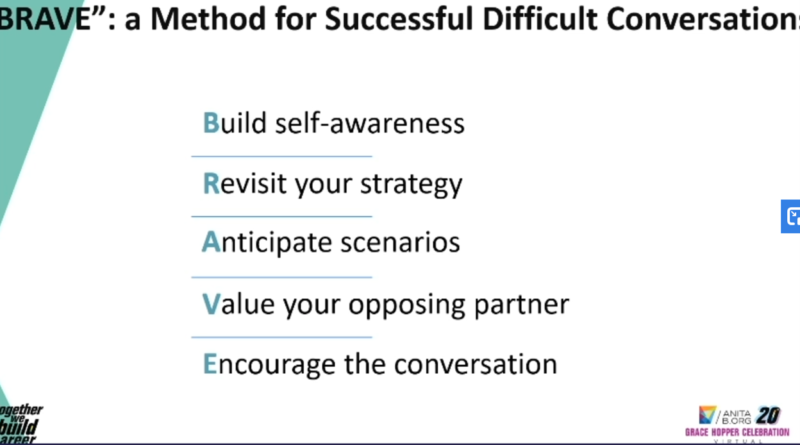BRAVE – A Method for Successful Difficult Conversations
I volunteered to be an official blogger for GHC20 (#GHC20, #GHC) and BRAVE framework presentation was one of my favorites. Due to pandemic, GHC was completely virtual (#vGHC2020) this year. All the speaker presentations were pre-recorded and are accessible for 60 days. While I could not attend this session during its scheduled time, I got a chance to watch the recording. Most of the content is verbatim from the presentation. Sincere thanks to the speaker for putting together this framework and sharing with us.
About the Speaker
Clio Lewandowski, Senior Human Resources Business Partner, Western Digital Corporation, has over fifteen years of experience. Throughout her career, she has coached numerous employees, managers and leaders from all over the world through difficult conversations and helped them rebuild broken relationships.
BRAVE framework
Over her 15 years as HR partner, speaker met with several people who were not brave enough to face difficult conversations. Speaker looked into their stories and learned the patterns. She realized that people either rush through difficult conversations, or delay them hoping it would eventually vanish. What she learned is that they did not prepare because they did not know how to. This is the reason she prepared BRAVE framework which is a pragmatic method to prepare difficult conversations to maximize impact and success.
BRAVE consists of the following five pillars:
Build self-awareness
Revisit your strategy
Anticipate scenarios
Value your opposing partner
Encourage the conversation
1.Build self-awareness
When we are in stress it has impact on our body, mind and behavior. That’s why we need to control it to get the best out of the situation.
Body
First start with the body. When we have to encounter difficult situation or when we are in distress our body prepares us for either a fight or flight response. We will tend to have a series of symptoms like voice shaking, sweating, shaking etc. When we get into a conversation in such stress, we are setting up the framework for a battle and not a partnership. That’s why we need to learn to control it and lower our stress level so that we can get best out of the situation. Here are three techniques to control it but there are several others that you can research and find the one that works for you:
- Superman pause: Put your fists on your hips, legs apart, chin up for two minutes and think about the goal right before the conversation. This decreases stress.
- Deep breathing to release tension.
- Stress pressure release points.
Mind
Once we have the body in control, we need to prepare our mind. By nature we are wired to assume negative intent. We have built up our own personal biases coming from past experiences, stereotypes, our upbringing etc. We don’t see the facts but see through these lenses. On average humans make decision in 150 milliseconds. In a stressful situation it is not probably going to make best decisions. We can learn to redirect the thoughts to go back to the truth and assume positive intent.
Behavior
Stress will reflect on your behavior. Understand and learn to control it. Communication is 7% words and 93% nonverbal and tone of voice. We need to control our behavior. Few tips. Monitor tone of voice. Bring your tone to a neutral level. Be inviting. Finally smile. When we smile, we are sending a signal that it is not a battle and it is a partnership. The other person will send those vibes back. Knowing yourself under stress will help you get the best out of the situation.
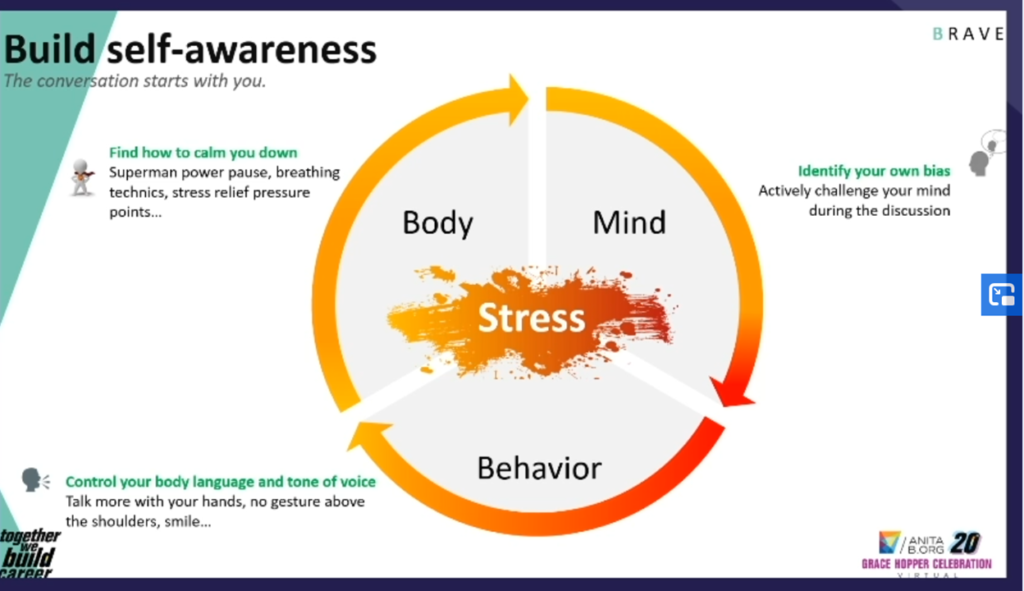
2. Revisit strategy
Once you have your stress under control, revisit your strategy.
Important to answer the four questions.
- Why – why do you want this. What is your true motive / goal. Be honest to yourself. Understand your true motive.
- What does a win look like – you will be able to steer the conversation to back to the wins and compromises.
- How – create interest for collaboration. Write down and think about how to invite for collaboration. Example – instead of saying – “Hey I have a problem and I think we need to talk”, rephrase it as “I have a problem and I think I need your help”. First sentence is setting up for a battle and the second sentence is inviting.
- When – Think about when you and the other person will be open for conversation and will be in the now without getting distracted. Example – avoid Monday 8 AM and Friday 5 PM or right before lunch.
- Where – Very important. Public places might not be friendly for true conversations. Find a neutral place where you can have this conversation like a conference room or a video conference.
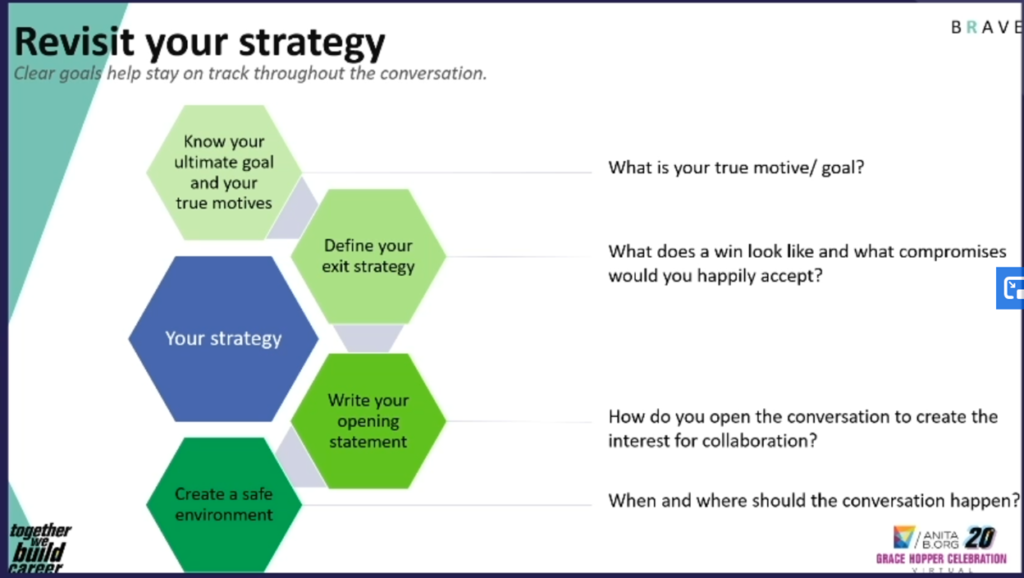
3. Anticipate scenarios
After you revisit your strategy, anticipate scenarios. When you build scenarios, you can integrate all the information into the mix. You cannot control everything but the more you are prepared the more the surprises can be turned into opportunities and help make your point.
Think about the environment, you and the other person. Knowing the context is important – example company is doing well vs company is not doing so great.
Avoid story telling. Typically, we will not know all the facts. There will be some gaps and we tend to fill the gaps with the story that we create. We create negative stories with our own filters. There are high chances that our stories are incorrect. Master context but be aware of storytelling. Learn to read peoples reaction.
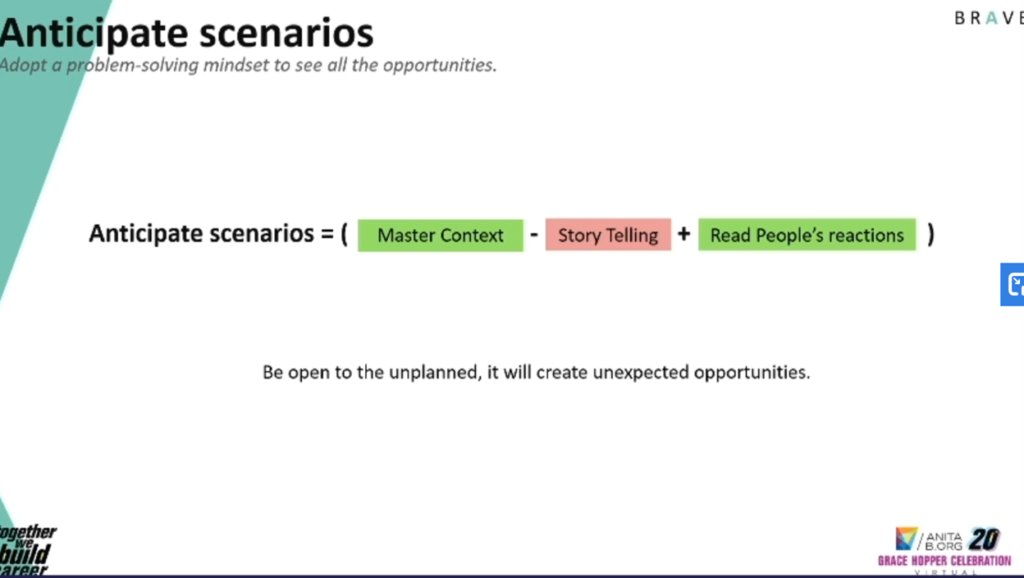
4. Value your partner
Think about the person you are working with as a partner. You need to show that you value your partner. To reach your goal you need to partner with them. The key work is partner. Leverage 3 basic things.
- Show respect – This is extremely powerful. An example – When FBI has to negotiate a hostage situation, they find everything they need to know about the person they are going to negotiate with. They go through the profile with an objective to find atleast one thing that they can respect. Once they have the one thing, then they start negotiation. The people will know within 15 secs if they are respected or not and there are higher chances of negotiation if they know they are respected. You don’t need to like them. You need to find one thing you respect in them.
- Give time – You know the situation, but the partner might not. It might be a complete surprise for them. They need time to absorb, time to process, and form thoughts. Don’t need to rush through it.
- Welcome differences – Make sure you make them feel that they are heard.
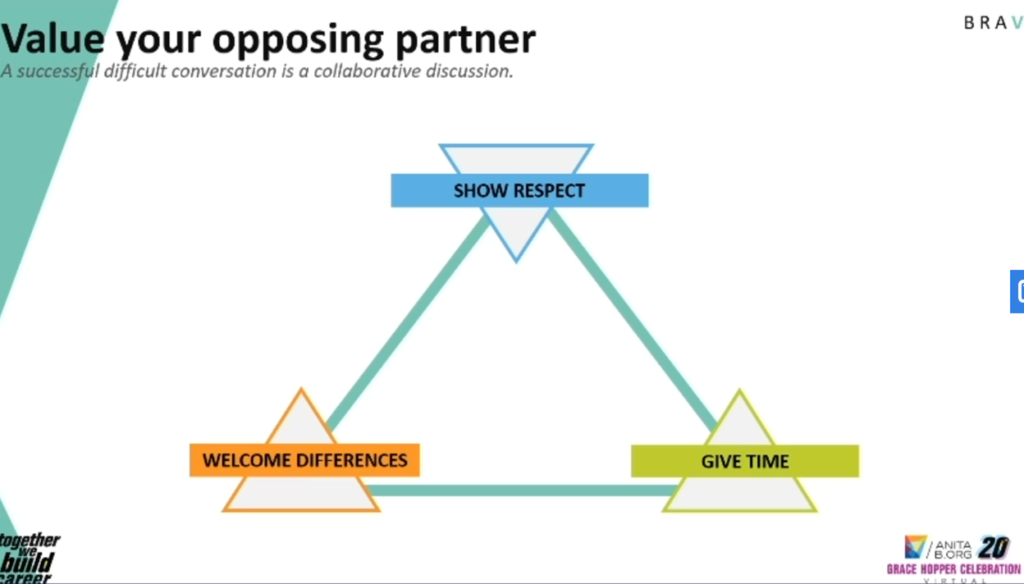
5. Encourage the conversation
Value your partner in the very beginning of the conversation. Do the following things when the conversation gets stuck:
- Restore safe environment – which is value your partner
- Offer them some control. They need to regain some control. Say something like ‘I can sense that you are not comfortable. Would you prefer a,b, or c (which are the options that work for you, the options you prepared when you explored the scenarios). This way they will feel that they have some control.
If the environment is safe and you want to revive the conversation, here are 4 easy ways.
- Genuinely ask what’s going on. Keyword is genuine. Say something like – “Something not working. Can you please help me understand what is going on?” Bring them back to talking. If they don’t talk then rephrase.
- Rephrase – shows you value your partner. If you are right and you have reaffirmed values and you bring them back to the safe space. If it is incorrect then they will correct and reengage. If this doesn’t work, then there is a third tool – mirroring.
- Mirror – this is extremely powerful. Doing and saying exactly what the other person is saying. Say the last 5 or 10 words. By doing this, you are telling them you are listening. Next adopt the same behavior as them. If they are defensive, you be defensive for exactly 5 seconds. No more than 5 seconds and come back to neutral. Humans are wired to mirror each other’s behavior. By retaking your neutral space you are inviting them to be neutral
- Take your best guess – if nothing works, take your best guess and say “hey is it because of xyz”. You are putting words into their mouth and if it is not their opinion and they will correct you. Point is to reengage. Once you reengage point is to understand their true motive. You need to get them to talk about their story. Lay out a solid foundation to build up the conversation.
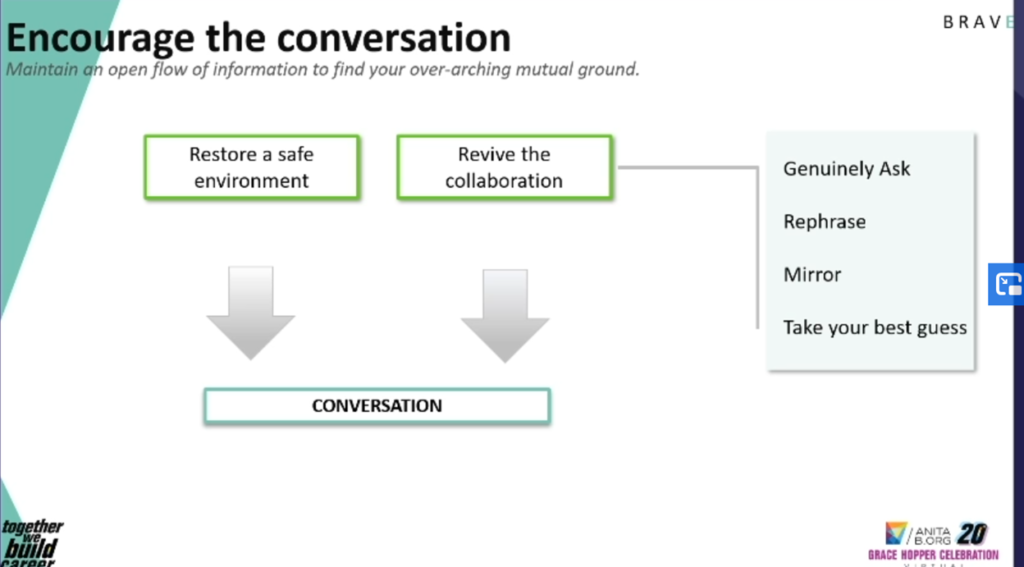
There you have it. That’s the framework. Sometimes speaking up is not easy. Making our point can be challenging and so preparation is key. It will help you have the self-confidence to be BRAVE in those difficult conversations. Try this method for your difficult conversation and find your voice. Be BRAVE.
